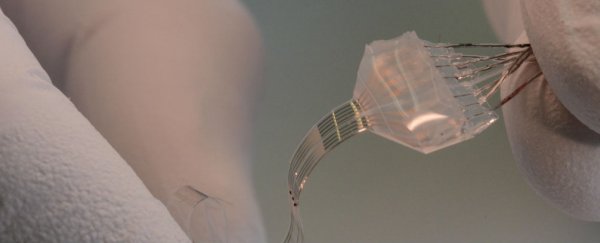If something's going to be implanted onto the surface of your brain, would you rather it be soft and squishy (like your brain itself) or hard and rigid like a bit of scrap metal? Our money is on the former.
Now, a new implantable prosthetic - dubbed e-dura - has been developed by researchers in Switzerland. It is modelled on something called dura mater, which is a layer of membrane that surrounds the brain and spinal cord. The soft device has been specially designed to deliver electrical impulses and, importantly, drugs, which will "reanimate the nerve cells" beneath damaged tissue.
The researchers say the risks of rejection and damage to the spinal cord with their new, biocompatible implant "have been drastically reduced".
"Our e-Dura implant can remain for a long period of time on the spinal cord or the cortex, precisely because it has the same mechanical properties as the dura mater itself," said investigator Stéphanie Lacour from the École Polytechnique Fédérale de Lausanne (EPFL), in a press release.
"This opens up new therapeutic possibilities for patients suffering from neurological trauma or disorders, particularly individuals who have become paralyzed following spinal cord injury."
Grégoire Courtine from EPFL was a co-author on the paper, published in Science. In 2012, he gained international attention when he showed that a paralysed rat could walk again through a combination of electrical and chemical stimulation (and the aid of a robotic harness). Watch below:

Making the same progress in humans, however, has been largely out of reach.
While certain "deep brain stimulation" devices are already being implanted in people with Parkinson's Disease, the type of device needed to potentially reverse paralysis in humans would need to be implanted on the surface of the brain or spinal cord. And it would need to remain there for long periods of time without causing any significant tissue damage.
Currently available surface implants, which are rigid, have limited lifespans. This is because natural human movement causes rubbing between the device and the surrounding tissue, and this repeated friction causes inflammation, scar tissue buildup, and eventual rejection.
The EPFL researchers tested their new device on paralysed rats. It was implanted on the spinal cord, beneath the dura mater, and left for six weeks. Soon, these rats were able to walk, and after the trial was over, they experienced no physical damage to their spines.
Another group of rats, meanwhile, had rigid devices implanted. These rats had trouble walking after just a few weeks, and later examinations revealed inflammation and deformation of the spinal cord.
Takao Someya of the University of Tokyo, who has developed a type of electronic skin, told IEEE's Spectrum that the e-dura device might produce more efficient therapies, given its highly targeted delivery of electric pulses and drugs.
"The challenge of their future work is to perhaps integrate more functionality into these devices, increase electrode densities, or tailor electrode placement to each specimen," Someya told Spectrum.
Source: IEEE's Spectrum
